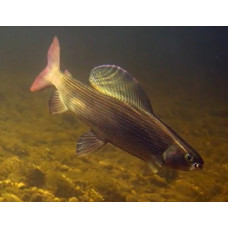Latin name
Thymallus thymallus
Other name
Grayling
Identification
The distinctive features of the European grayling are its spindle-shaped body, its upper jaw that reaches the front edge of the eye, its 19-30 gill rakers, and its 57-61 vertebrae.
Features of fish fins
These fish have a dorsal fin with 5-8 hard rays and 12-17 soft rays. The anal fin has three to four hard rays and nine to ten soft rays.
Fish colouring
The pectoral fins of the European grayling are gray without any red spots. There are no red spots on the body. The dorsal fin is grayish with parallel rows of round, dark dots.
Distribution
This fish species is native to Europe. It is widespread throughout the continent, from Britain and France to the Ural Mountains in Russia and the Balkans in southeastern Europe. However, it is not found in the southern parts of Europe. It was introduced to Morocco in 1948, though it did not become established there.
Habitat
This benthopelagic species prefers freshwater or brackish water and temperate climates. pH range: 7.0-7.5. Its depth range is: 15-? m. They inhabit foothill river valleys with hard, sandy, or rocky bottoms, as well as well-oxygenated, cold, fast-moving water.
Size
This species of fish usually grows to a maximum length of 30 cm, though it can reach up to 60 cm. The maximum weight is 6.7 kg. The maximum life expectancy is 14 years.
Behavior
This is a non-migratory species. It usually inhabits hollows behind boulders and shaded areas under overhanging vegetation. It is sociable and forms flocks. It is very sensitive to pollution.
Food and feeding habits
They feed on crustaceans, insects, spiders, mollusks, and small fish, such as Phoxinus.
Reproduction
The European grayling nests in shallow areas that are usually 20 to 40 centimeters deep. It also nests in ditches with a moderate current and a sand or pebble bottom.
Fishing
In the UK, fish can be caught throughout the fly fishing season, which runs from June 16 to March 14. In France, however, the season is limited by several factors. The River Allier is one of the few places in southern Europe where these fish live naturally. In Karelia, grayling is a valuable commercial fish. Locals typically catch it by spinning with the help of trollers. The catch is limited only by spawning bans.
Relationship with a person
Harmless. The French highly prize this fish.
| Classification | |
| Phylum | Chordata |
| Class | Actinopterygii |
| Squad | Salmoniformes |
| Family | Salmonidae |
| Genus | Thymallus |
| Species | T. thymallus |
| Features | |
| Conservation status | Least Concern |
| Habitat | Pelagic |
| Life span, years | 14 |
| Maximum body weight, kg | 6,7 |
| Maximum length, cm | 60 |
| Sailing speed, m/s | No information |
| Threat to people | Edible |
| Way of eating | Predator |
European grayling
Tags: european grayling



